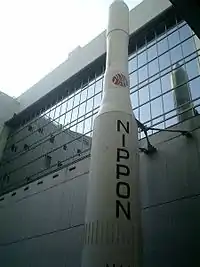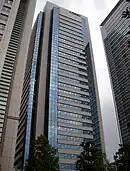 The N-I rocket[1] | |
| Function | Carrier rocket |
|---|---|
| Manufacturer | McDonnell Douglas (design) Mitsubishi Heavy Industries (production) |
| Country of origin | United States (design) Japan (production) |
| Size | |
| Height | 34 metres (112 ft)[1] |
| Diameter | 2.44 metres (8.0 ft) |
| Mass | 131,330 kilograms (289,530 lb)[1] |
| Stages | 2 or 3 |
| Capacity | |
| Payload to LEO | |
| Mass | 1,200 kilograms (2,600 lb)[1] |
| Payload to GTO | |
| Mass | 360 kilograms (790 lb)[1] |
| Associated rockets | |
| Family | Delta |
| Launch history | |
| Status | Retired |
| Launch sites | LA-N, Tanegashima |
| Total launches | 7 |
| Success(es) | 6 |
| Partial failure(s) | 1 |
| First flight | 9 September 1975 |
| Last flight | 3 September 1982 |
| Boosters – Castor 2 | |
| No. boosters | 3[2] |
| Powered by | 1 TX-354-3 |
| Maximum thrust | 258.9 kilonewtons (58,200 lbf) |
| Specific impulse | 262 sec |
| Burn time | 37 seconds |
| Propellant | Solid |
| First stage – Thor-ELT | |
| Powered by | 1 MB-3-3 |
| Maximum thrust | 866.7 kilonewtons (194,800 lbf) |
| Specific impulse | 290 sec |
| Burn time | 270 seconds |
| Propellant | RP-1/LOX |
| Second stage | |
| Powered by | 1 LE-3 |
| Maximum thrust | 52.9 kilonewtons (11,900 lbf) |
| Specific impulse | 290 sec |
| Burn time | 246 seconds |
| Propellant | NTO/A-50 |
| Third stage (optional) – Star-37N | |
| Powered by | 1 solid |
| Maximum thrust | 45 kilonewtons (10,000 lbf) |
| Specific impulse | 290 sec |
| Burn time | 42 seconds |
| Propellant | Solid |

Mock up of N-1
The N-I or N-1 was a derivative of the American Thor-Delta rocket, produced under license in Japan. The N stood for "Nippon" (Japan). It used a Long Tank Thor first stage, a Mitsubishi Heavy Industries-designed LE-3 engine on the second stage,[3][4][5] and three Castor SRMs.[2][6] Seven were launched between 1975 and 1982, before it was replaced by the N-II. Six of the seven launches were successful, however on the fifth flight, there was recontact between the satellite and the third stage, which caused the satellite to fail.
On 29 February 1976, the second N-I conducted the only orbital launch to occur on a leap day.[7]
Launch history
| Flight No. | Date / time (UTC) | Rocket, Configuration |
Launch site | Payload | Payload mass | Orbit | Customer | Launch outcome |
|---|---|---|---|---|---|---|---|---|
| 1(F) | 9 September 1975 05:30[8] |
Tanegashima | ETS-1 (JETS-1/Kiku-1)[9] | LEO | Success | |||
| 2(F) | 29 February 1976 03:30[8] |
Tanegashima | ISS-1 (JISS-1/Ume-1)[10] | LEO | Success | |||
| 3(F) | 23 February 1977 08:50[8] |
Tanegashima | ETS-2 (Kiku-2)[11] | GTO | Success | |||
| 3rd stage used | ||||||||
| 4(F) | 16 February 1978 04:00[8] |
Tanegashima | ISS-2 (JISS-2/Ume-2)[10] | LEO | Success | |||
| 5(F) | 6 February 1979 08:46[8] |
Tanegashima | ECS-A (Ayame-1)[12] | GTO | Partial failure | |||
| 3rd stage used; Recontact between satellite and upper stage. | ||||||||
| 6(F) | 22 February 1980 08:35[8] |
Tanegashima | ECS-B (Ayame-2)[12] | GTO | Success | |||
| 3rd stage used | ||||||||
| 9(F) | 3 September 1982 05:00[8] |
Tanegashima | ETS-3 (Kiku-4)[13] | LEO | Success | |||
See also
References
- 1 2 3 4 5 Wade, Mark. "Delta". Encyclopedia Astronautica. Archived from the original on 17 August 2013. Retrieved 3 September 2008.
- 1 2 "JAXA Digital Archives". Japan Aerospace Exploration Agency. Archived from the original on 9 September 2009. Retrieved 1 October 2009.
- ↑ "N-Iロケット開発の歩み". Yukihiko Takenaka, NASDA. Retrieved 10 February 2011.
- ↑ "三菱重工 名古屋誘導推進システム製作所 事業所紹介 沿革". Mitsubishi Heavy Industries. Archived from the original on 4 July 2011. Retrieved 10 February 2011.
- ↑ "第1部 創造性豊かな科学技術を求めて 第2章 自主技術開発への展開 第3節 先導的・基盤的科学技術分野における自主技術開発の展開 2.宇宙開発". Ministry of Education, Culture, Sports, Science and Technology. Archived from the original on 15 June 2008. Retrieved 10 February 2011.
- ↑ Krebs, Gunter. "N-1". Gunter's Space Page. Retrieved 31 August 2008.
- ↑ Pearlman, Robert (29 February 2016). "Space Station Command Change Is One Giant Leap (Day) for Space History". Space.com. Retrieved 2 November 2017.
- 1 2 3 4 5 6 7 McDowell, Jonathan. "Thor". Orbital and Suborbital Launch Database. Jonathan's Space Report. Retrieved 31 August 2008.
- ↑ "JAXA | Engineering Test Satellite I "KIKU-1" (ETS-I)". JAXA | Japan Aerospace Exploration Agency. Retrieved 16 March 2020.
- 1 2 "JAXA | Ionosphere Sounding Satellite "UME" (ISS)". JAXA | Japan Aerospace Exploration Agency. Retrieved 16 March 2020.
- ↑ "JAXA | Engineering Test Satellite II "KIKU-2" (ETS-II)". JAXA | Japan Aerospace Exploration Agency. Retrieved 16 March 2020.
- 1 2 "JAXA | Experimental Communications Satellites "Ayame" (ECS)". JAXA | Japan Aerospace Exploration Agency. Retrieved 16 March 2020.
- ↑ "JAXA | Engineering Test Satellite III "KIKU-4" (ETS-III)". JAXA | Japan Aerospace Exploration Agency. Retrieved 16 March 2020.
This article is issued from Wikipedia. The text is licensed under Creative Commons - Attribution - Sharealike. Additional terms may apply for the media files.

